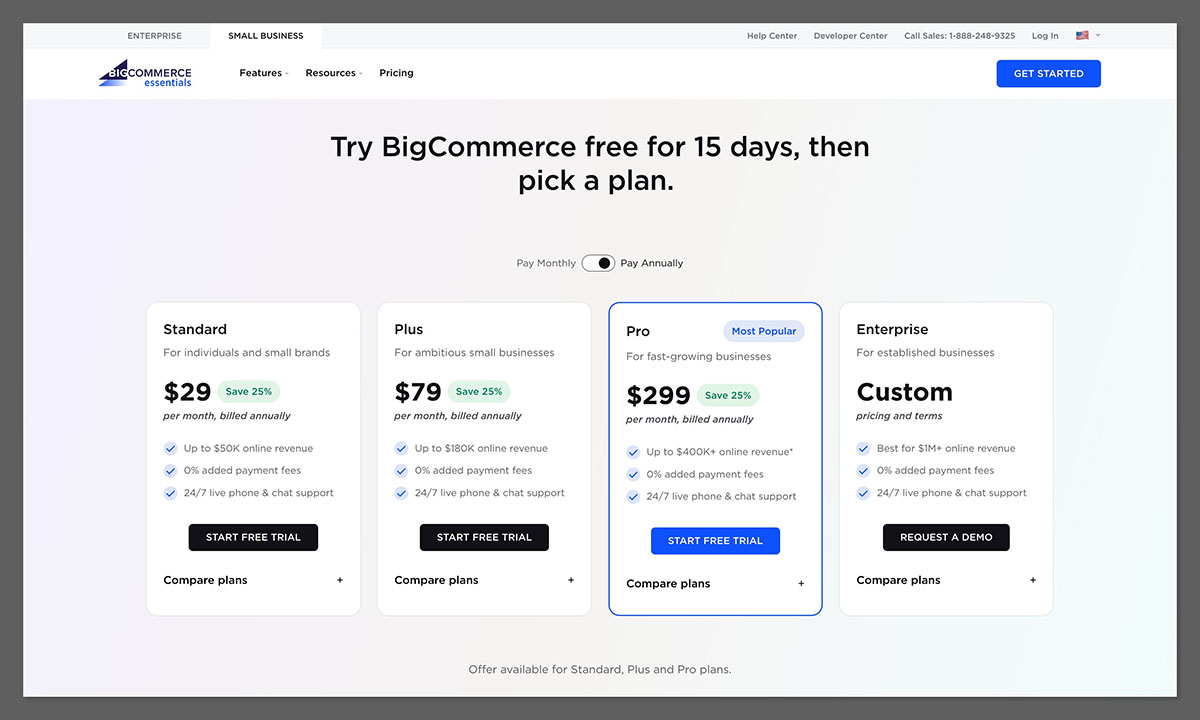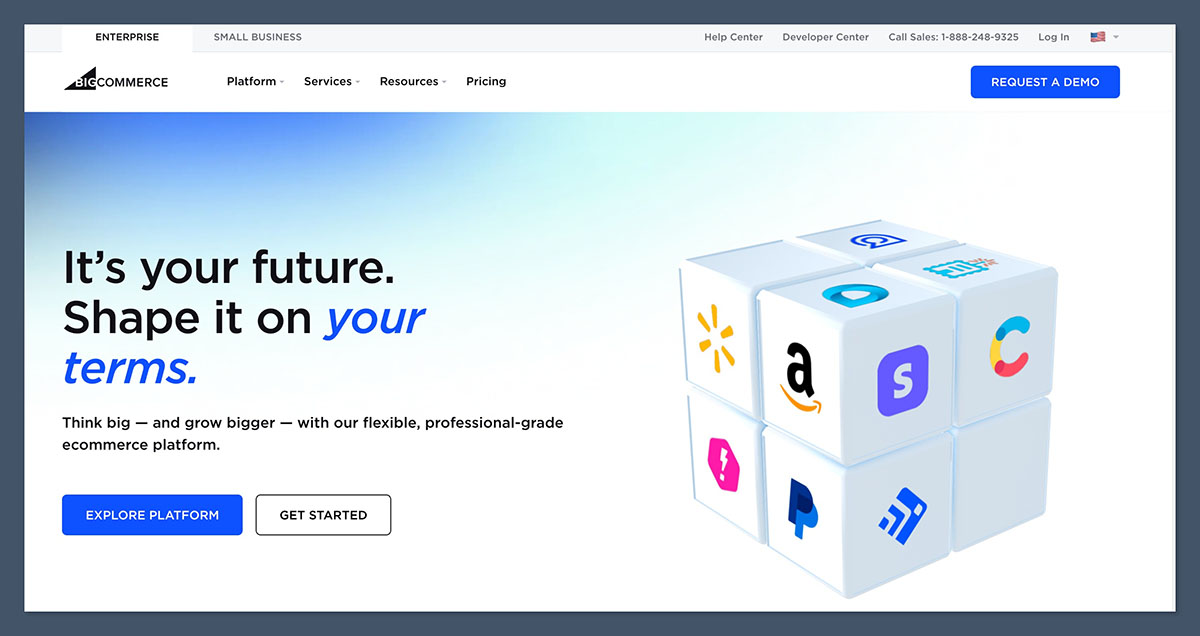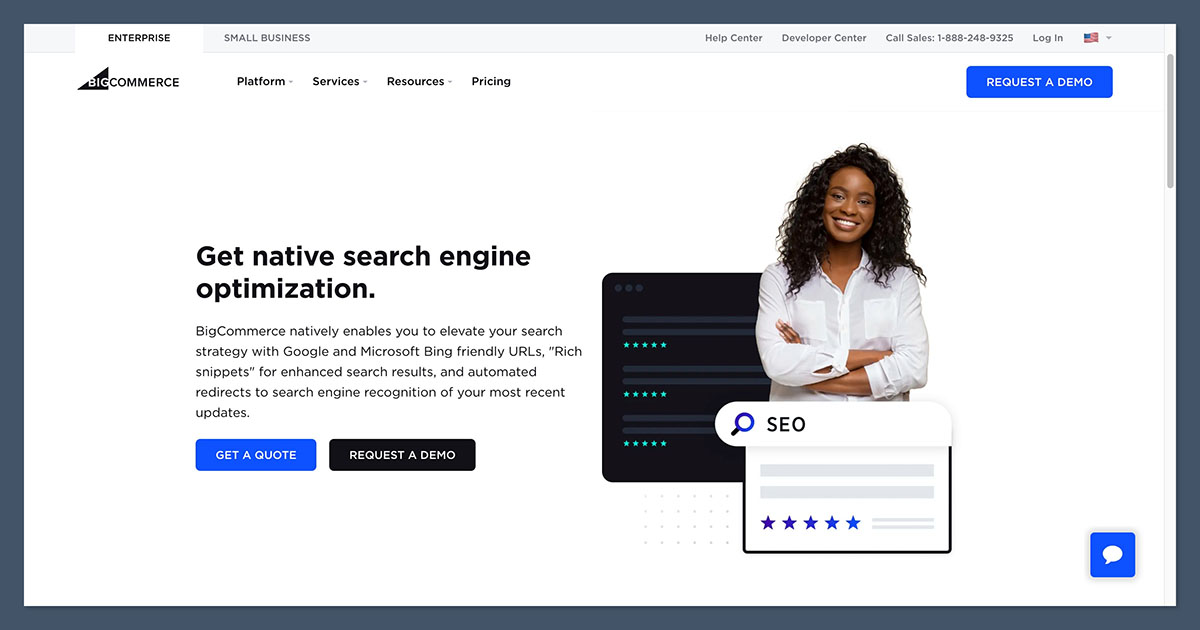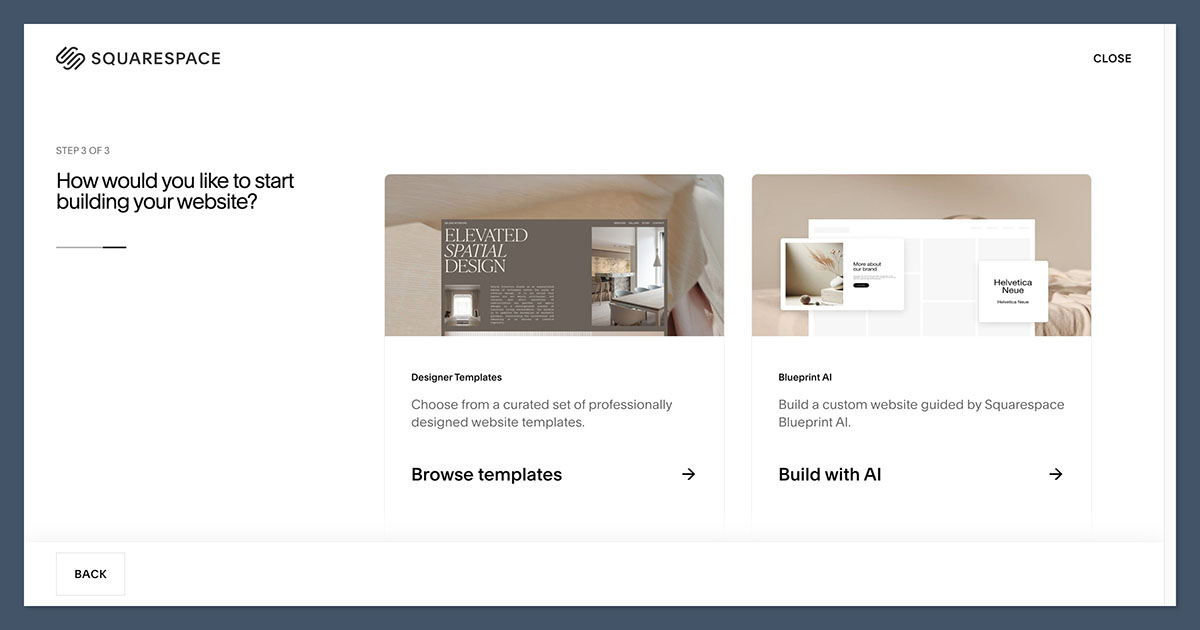BigCommerce and Squarespace are two big players in the website building space — but they serve very different purposes.
After over 10 years running ecommerce businesses, testing every platform under the sun, I’ve learned that choosing the right builder can either fuel your growth or silently kill it.
In this detailed review, I’ll compare BigCommerce and Squarespace based on what actually matters: pricing, ecommerce tools, SEO, templates, usability, and support.
You’ll get honest insights backed by real experience — not just surface-level features.
BigCommerce vs Squarespace: Quick Verdict
BigCommerce – Best for growing ecommerce brands with large product ranges and serious SEO goals
Squarespace – Best for creatives or service businesses that want a stylish site with simple selling
In this comparison, I’ll unpack everything from product management to templates, SEO performance, and more — to help you make the right call for your business.
Quick Comparison Table
| Feature | BigCommerce | Squarespace |
|---|---|---|
| Overall Rating | 4.3 | 4.1 |
| Starting Price | £30/month | £16/month |
| Best For | Scaling ecommerce | Portfolios and small shops |
| Product Variants | Unlimited | Limited |
| SEO Tools | Advanced | Basic |
| Templates | Functional | Stylish |
| Ease of Use | Moderate | Very easy |
| Support | 24/7 + onboarding | 24/7 live chat |
Best for Pricing: Depends on Your Scale
When comparing prices, both BigCommerce and Squarespace seem similar — but the real difference lies in how they scale with your business.
BigCommerce’s plans start at $29 per month, and include robust ecommerce functionality like multi-channel sales, advanced product options, and no transaction fees.
However, pricing tiers are linked to your annual revenue. If your store crosses certain sales thresholds, you’ll be bumped to a higher plan automatically — which can catch new sellers off guard.
The plans break down like this:
- Standard – $29/month
- Plus – $79/month
- Pro – $299/month+

Each plan unlocks new features, such as customer segmentation and product filtering.
Squarespace is more straightforward. You’ll pay $23/month for the Business plan (with a 3% transaction fee), or $28/month for Commerce Basic (no fees, full ecommerce functionality).
Their pricing doesn’t scale based on revenue, so it’s more predictable.
But the downside? You get fewer ecommerce tools for that flat rate.
The Winner: It’s a draw
If you’re a small business focused on design and ease, Squarespace is cheaper and simpler.
If you’re planning to scale and want enterprise-level features baked in, BigCommerce becomes more cost-effective in the long run — even with the tiered pricing.
Best for Selling Online: BigCommerce Is Built for Scale

This is where BigCommerce pulls ahead — and it’s not close. I’ve built stores on both platforms, and when it comes to selling at scale, BigCommerce is simply more robust.
With BigCommerce, you can:
- List unlimited products with complex options (colour, size, material, etc.)
- Offer real-time shipping rates and advanced tax settings
- Sell across Amazon, eBay, Walmart, and Google Shopping
- Use over 65 payment gateways with no additional transaction fees
- Enable multi-currency checkout
- Handle wholesale pricing and customer groups
You also get features like abandoned cart recovery and advanced discount rules out of the box — no third-party app needed.
Squarespace supports basic ecommerce functions — like product listings, checkout, and discounts — but it’s not designed for complex setups.
You’re limited to 100 SKUs per product, which becomes a problem fast if you have multiple variants. Shipping and tax tools are there, but basic. And it only integrates with Stripe, PayPal, Afterpay, and a couple of others.
Want to sell on Amazon or Facebook? You’ll need third-party tools — and setup isn’t always smooth.
The Winner: BigCommerce
BigCommerce gives you everything you need to run a full-scale online store — without needing to patch features together with paid apps.
Best for Marketing & SEO: BigCommerce Gives You More Control

Marketing is about visibility — and SEO is the engine behind that visibility.
Squarespace includes the basics: meta titles, descriptions, image alt text, and clean URLs.
The blogging platform is excellent, which is great for content marketing or service-based businesses. It also has decent email marketing tools, especially with the integrated email campaigns builder.
But when it comes to technical SEO — the stuff that moves the needle — it’s limited.
You can’t manage your sitemap or robots.txt directly, you’re locked into their URL structures, and the lack of advanced schema options hurts product visibility in search.
BigCommerce, by contrast, gives you:
- Full control over URL structure and redirects
- Editable robots.txt and sitemap files
- Built-in schema markup for products
- AMP support for mobile pages
- Faster page speeds and better Core Web Vitals performance
- Rich product filtering and faceted navigation
It also integrates more easily with Google Merchant Center and other PPC/SEO tools.
The Winner: BigCommerce
If SEO matters — and it should — BigCommerce is leagues ahead. It’s optimised from the ground up for product discoverability and technical search performance.
Best for Templates: Squarespace Looks Better Out of the Box

Squarespace’s reputation for beautiful design is well earned.
Their templates are sleek, mobile responsive, and tailored for creatives. Whether you’re a photographer, designer, coach, or small boutique brand — your site will look polished without much effort.
You get access to around 100 free templates, all of which are customisable using the drag-and-drop editor. Fonts, colours, layouts — it’s all intuitive.
BigCommerce? Not so much. You’ll find around 150 templates, but only a dozen are free. Most premium templates cost $100–$250, and many of them look dated unless customised heavily.
The built-in Page Builder helps, but you’ll need some dev support if you want something truly custom.
The Winner: Squarespace
Squarespace is still the best-looking builder for non-designers. If visual branding is key to your business, you’ll get a better result faster on Squarespace.
Best for Ease of Use: Squarespace Is Smoother for Beginners

If you’ve never built a site before, Squarespace is easier — no question.
Setup is fast. The onboarding guides are simple, and the interface is clean. You don’t need to know code.
You don’t need to worry about plugins. You just pick a template, customise the content, and publish.
With BigCommerce, there’s a learning curve. It’s not difficult, but it’s built for people who know what they’re doing.
You’ll need to configure more backend settings: taxes, shipping zones, payment gateways, product variants. It’s powerful, but more complex.
Squarespace, by comparison, makes decisions for you. That’s limiting — but beginner-friendly.
The Winner: Squarespace
If ease of use is your top priority, Squarespace wins. It’s designed to be foolproof — BigCommerce gives you more flexibility, but expects more from you.
Best for Support: BigCommerce Has a More Ecommerce-Focused Team

Both platforms offer 24/7 support, but the experience is very different.
Squarespace’s support is quick and friendly. Live chat is responsive, and the help guides are clear. But the team is mostly trained on design and functionality — not ecommerce strategy.
So if you run into issues with taxes, product feeds, or checkout flows, you may hit a wall.
BigCommerce offers 24/7 chat, phone, and email support. What sets them apart is the ecommerce knowledge. They understand conversion rate optimisation, inventory rules, international tax zones — the stuff that matters at scale.
Enterprise users also get a dedicated account manager, which can be a game-changer if you’re managing a large store.
The Winner: BigCommerce
Squarespace nails design support. BigCommerce nails ecommerce support. If you’re running a proper online store, that difference matters.
Final Verdict: Which Should You Use?
It all comes down to what kind of business you’re building.
If you’re building a real ecommerce brand — one that you want to scale, optimise for SEO, and maybe even exit someday — go with BigCommerce. It’s got the infrastructure, features, and growth potential.
But if you’re a solo creator, artist, or service-based business, and ecommerce is just one part of what you do — Squarespace is perfect. It’s easy, beautiful, and fast to launch.
The Winner
| If you’re building… | Choose |
|---|---|
| A product-heavy brand | BigCommerce |
| A content-first website | Squarespace |
| A creative portfolio with light selling | Squarespace |
| A long-term ecommerce business | BigCommerce |
| A store optimised for SEO | BigCommerce |
Final Thoughts From 10+ Years in the Game
I’ve seen brands succeed on both platforms — but they succeed for different reasons.
BigCommerce is for growth.
Squarespace is for simplicity.
Don’t pick the one that looks best today. Pick the one that works best tomorrow.






